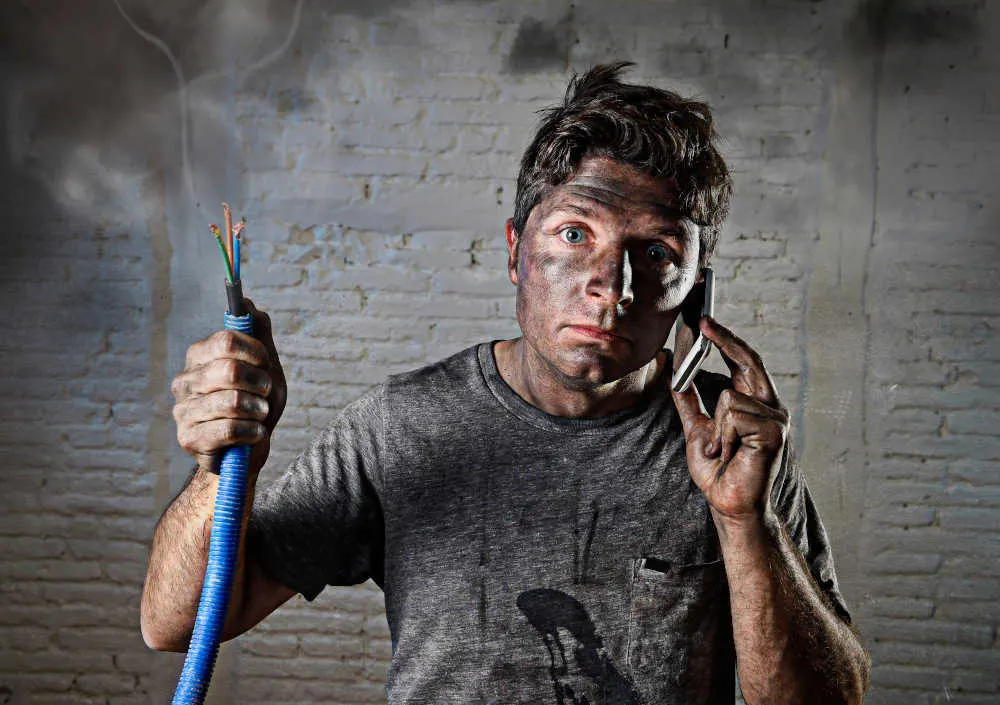Done right, wiring an electric hot water heater with a storage tank should be a straightforward enough DIY project. If you’re like me, you don’t want to pass up the opportunity to learn something new (and save a few $$$!) by tackling the wiring of your water heater.
However, keep in mind that it is extremely important to understand and carefully follow the correct procedure for wiring a water heater. Any carelessness or sloppy work could have dangerous, even lethal consequences.
This guide tells you exactly how to prep and wire your water heater, and get the hot water flowing out your faucets. A section at the end lists useful Dos and Don’ts to help you avoid common but costly mistakes.

An electric water heater typically runs on a 240V, 30A dedicated circuit with double-pole circuit breakers. In this setup, the water heater’s electricity supply comes through a 10/2 AWG cable carrying two live (hot) wires insulated in black and white, and a third, naked wire for grounding to earth.
How to Wire Your Water Heater the Safe Way

As usual, before beginning work on anything that involves electricity, you must make sure to turn off the power supply. To do so, go to the mains panel, and turn the double circuit breakers for the water heater circuit to ‘OFF’. Tape a sign over them to ensure that the power is not turned back on until you’re ready.
Whether you’re working to wire a new water heater or reconnecting an old one, it’s a good idea to turn off the water supply by turning the cold-water inlet valve near the top of the water heater to ‘OFF’. (See how to find and turn off the cold-water inlet valve in this post.)
Now, follow the procedure below carefully to set up the wiring for your water heater, taking care not to omit any steps, or get the order mixed up.
Ten Steps to Wiring an Electric Water Heater
- First, verify that your water heater does indeed run on a 240V, 30A circuit. A simple check is to make sure that there are double circuit breakers, with “30A” embossed on each. It’s also a good idea to check that the water heater power supply cable has a “10/2” AWG rating, at minimum.
(IMPORTANT! Remember that with wire gauge, a greater AWG number indicates a thinner wire or smaller wire diameter. So, if your power supply cable has an AWG value greater than 10, like 12 or 20, that means the wire is thinner than recommended and is NOT suitable for this high-voltage application. If the cable is an AWG size lower than 10, like 8 or 6, the wire is thicker than the minimum required and can be safely used.)
- Using a multi-meter(Amazon), test that there is no electricity supply in the wires of the household electricity supply. (When you hold the two multi-meter leads between the incoming black and white wire ends, the voltmeter reading should be ‘0’.)
- Find the junction box on the top of your water heater, and unscrew the lid (usually round or rectangular, with a circular, knock-out panel for the electricity cable to pass through). Get the knockout panel out, and draw the flex line through the junction box lid.
- In old water heaters, you might see a metal ‘grounding screw’ visible at one corner of the junction box lid. Newer models have a green colored grounding screw concealed within the junction box. Besides the grounding screw, the junction box should have two wire ends, insulated in red and black.
- The first connection must always be the grounding wire. Unscrew the grounding screw, loop the naked, grounding wire around it, and screw it back in securely. (Be sure to thread the grounding wire through the little raised hatch on the second panel of the junction lid in older water heater models with a rectangular, two-part junction lid.)
- Connect the black wire from the electricity supply to the black wire from the water heater. Connect the electricity supply white wire to the water heater red wire. (Switching these will not make a difference in this case. However, it’s common practice to connect colors in the right pairing.) Twist the wire ends together for each connection, secure them with wire nuts (typically red nuts for wires rated for water heaters), and wrap black insulation tape beneath each wire nut for added safety.
- Make sure to tag the incoming white wire with either red or black insulation tape, to indicate that this is a ‘hot’ wire and not a neutral.
(A water heater uses a single, split-phase electricity supply in which there are two ‘legs’ of 120V each that sum to 240V. Split-phase means that the two legs work in alternation, with one turning positive while the other is negative, thus completing the circuit in the absence of a neutral.)
- Push the connected wires back into the junction box, folding them over neatly to lie completely inside the box, and screw the junction box lid back on.
- Open the cold-water inlet valve to fill up the water heater tank, and turn on a hot water faucet to allow air trapped in the plumbing to empty. Turn off the faucet only after water has been flowing freely for about a minute.
- Reconnect the electricity supply to the water heater by turning the main circuit breakers back to ‘ON’.
Important Dos and Don’ts When Wiring a Water Heater

- Make sure that the electricity supply to your house is compatible with your water heater. If you’re not sure whether the electricity supply is a 240V setup, it might be safest to call in a professional electrician to do the rewiring necessary to wire the water heater safely. (For example, if you see a single circuit breaker for the water heater circuit, or an electricity cable with a different AWG rating like 12/2, better call an electrician.)
- Take safety precautions:
- Be sure to tag the white wire for the incoming electricity supply with red or black insulation tape for ‘hot’ (see step #7 in the step-by-step wiring guide above).
- Ensure that the grounding wire is firmly attached to the grounding screw.
- Use wire nuts and black insulation tape to ensure that naked wire ends cannot accidentally come into contact with each other, causing a short-circuit.
- All wires must be fully concealed inside the junction box. Leave no loose wires exposed.
- Avoid heating element burnout; Fill up the water heater tank before reconnecting power to the water heater.
Now that you’re clear on the dos and don’ts of wiring an electric water heater, you’re all set to wire like a pro!

